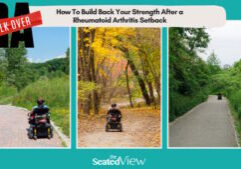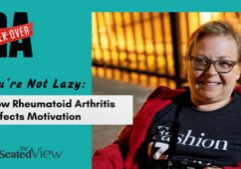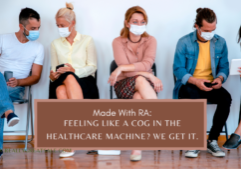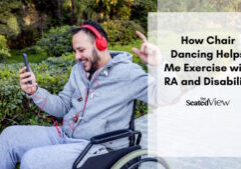Out Among the English: Body Language & Disability
A couple of weeks ago, I wrote about physical barriers tosocial interaction, mostly in terms of design issues and aspects that can be corrected by having some chairs in the place. Today, Part II. Namely physical barriers to interpersonal communication.
Say that you’re
- At a formal occasion – a wedding, formal business event and the like – and you’re seated at a large round table with 9 other guests. The person next to you is having a fascinating discussion with the person next to them and you want to join in. What do you do?
- At a party where you don’t know anyone and don’t feel like spending any more time standing by yourself by the potted plant looking fascinated by what your invisible friend is saying. You even feel brave enough to sidle up next to one of the multitude who you don’t know and try to start a conversation. What do you do?
- You’re talking to a stranger, perhaps at a party or maybe at a bar, museum or in a restaurant on a first date. You’re feeling that tingling in the pit of your stomach that means you’d like to explore being much more than friends. Short of stating it baldly or pouncing right there, in the bar, restaurant or bus stop, what do you do?
Enter the disability as complicating factor. For the purposes of this post specifically those requiring the use of a wheelchair. And shortly, even more specifically the type of disability that affects mobility in other bits in addition to your legs.
How many conversations start with a look and a smile? It’s how we test the waters to see if conversation would be welcome, it’s how we engage in that first leap, build a bridge between two people. But if your smile happens at other people’s crotch level, it can be a bit problematic to catch somebody’s eye. From a woman’s point of view, you might consider it payback for all those times women had to tell men that their eyes were in their head, not at chest level, but very few people notice the direction of your gaze if they’re looking down at the top of your head. So you have to say something to engage with someone and if you’re in a noisy environment, whether in a talky crowd or place where the music is more than merely background, it involves yelling. All while craning your head back so you can do that eye contact thing. That is, if the person hears you and looks down and not withstanding issues with your neck that make it impossible to look up.
The party being seated can help somewhat, because at least you eyes are more or less at the same level, but let’s take a visit to that large round table and see what else happens. In some ways it’s a good equalizer because you are an exact same situation as an able-bodied person – those tables are so large you rarely talk to the people on the other side of the table. But you do talk to the person seated next to you and sometimes, a smallish group is created when the person next to them joins in. But how do you indicate you would like to be part of such a conversation? You lean forward and over, close to the person next to you and the two people having a conversation understand that body language cue and (if they’re not hopelessly rude) make room to include you. But what if you can’t move like that? What if your body isn’t good at leaning forward and to the side leaving you without a cue – and your neighbours without a clue – that you’d like to contribute. And then there’s the part that staying apart instead of leaning in is also a body language cue that you’re not really interested in meeting other people. So there you are, not able to move much, the place is noisy so it’s difficult to yell “hey, I’d like to talk with you guys!” Not to mention not good manners and just not something that most people is comfortable doing in such a situation. Because we’ve all seen that movie where a hush falls the nanosecond before you open your mouth and then the entire room will stare at you.
And then there’s the part about the subtle body language that tests the waters of romantic interest. I’ve watched TV programs about body language in such situations and they include leaning into the other person (covered above), touching them on the arm (what if your reach is limited?), grooming gestures to yourself and the other person (difficult if your mobility and dexterity is affected). And other people don’t touch you, because the wheelchair creates a pretty effective barrier to touch – and that’s enough material for several posts – not to mention that it seems as if some believe the cripple is going to crumble into pieces if touched. It leaves you in an odd no-(wo)man’s land of having to read between the lines or perhaps being very forward, skipping over that subconscious dance of two bodies checking interest level in each other. Which usually doesn’t work because you haven’t had the dance and without it, things don’t bud quietly and you’re out of sync. Which may be it’s one of the contributing factors to people with disabilities often being viewed as asexual (aside from lack of imagination on the part of the ablebodied). When that subconscious dance may be impossible, just as it can appear as if we are not interested in conversation, without the appropriate/recognizable body cues, we appear not interested in romance or sex. Which also is a post in itself.
I’m starting to wonder if much of the space around a person in a wheelchair that you so often see in a public or social situation is due, at least in part, to us not sharing a language, physically speaking. Our body language is not recognizable to others, in much the same way that Russian is unintelligible to most English speakers. Although it does differ in a very significant way. Because the Russians can learn English – and by hanging around someone who has a disability, the English can learn Russian – but we cannot learn a different body language. Because if you can’t move freely, you can’t speak ablebodied.
Read More
Discover what else I've been writing about...















